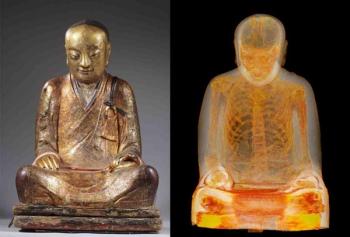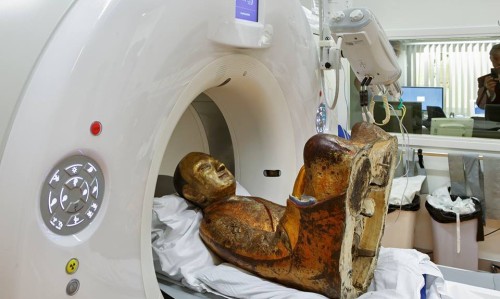
CT scan of statue. From Drents Museum
from Buddhistdoor International
Naushin Ahmed 2015-04-01
The statue, which contains the mummified remains of a monk, was on display at an exhibition titled Mummy World at the Hungarian Natural History Museum when its owner, a Dutch private collector, removed it on 20 March. A statement released by the collector said he had obtained the statue legally in 1994 (other reports say the transaction occurred in 1995 or 1996) from “a sincere Chinese friend in the art circles” (China Daily USA). The statue was bought for US$19,786 (china.org.cn) and shipped to the collector’s residence from Hong Kong.
That same year, villagers in Yangchun, Fujian Province, reported that a Buddhist statue had been stolen from their village temple.
Zhang Yongping, director of Fujian Relics Authentication Center, confirmed that the statues are in fact the same item: “We made several comparisons between the publicized information of the statue in Budapest, and the historical records of the stolen statue in Fujian—It’s a match. For example, Zhanggong Zushi the buddha is documented in the pedigree of Lin Family in Yangchun in the 11th century. The buddha was mummified after he died at the age of 37; Besides the identity, the cushion and kasaya on exhibit match our photo archive of the stolen statue, which were taken in 1989” (cctv.com).
On seeing the statue of their former ancestor on Chinese TV, the villagers of Yangchun wept and set off fireworks. The Cultural Relics Bureau in Fujian Province had been investigating the whereabouts of the statue since its disappearance.

The statue on display at the Hungarian Natural History Museum, Budapest. 3 March 2015. From Xinhua/Attila Volgyi
Yangchun archives depict the mummy as a local monk praised for “helping people treat disease and spread Buddhist belief” (cctv-america.com). The monk, named Zhanggong Zushi, was mummified and placed within the statue after his death at the age of 37. According to the archives, the monk lived during China’s Song dynasty (960–1279). He has been venerated at the village temple ever since. Continue reading →








